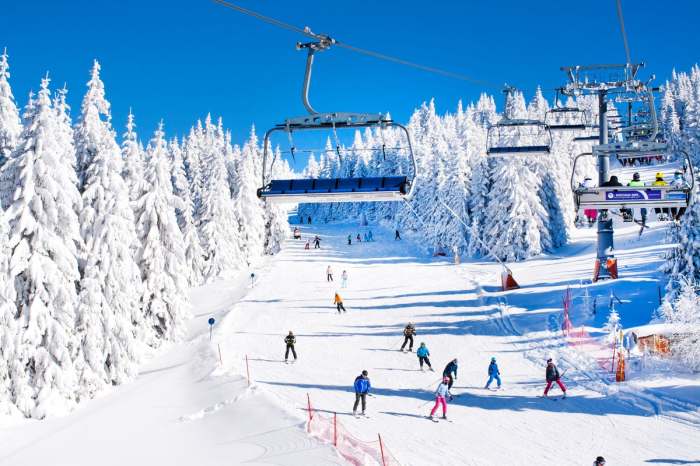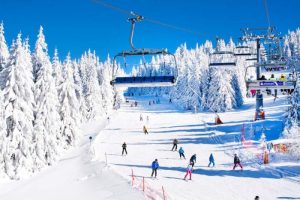
Winter sports enthusiasts are always seeking out the next adrenaline-pumping adventure, whether it’s carving down pristine slopes, exploring untouched backcountry, or gliding across frozen lakes. The world offers a myriad of destinations that cater to every level of winter sports enthusiast, from seasoned pros to first-time skiers and snowboarders.
From the towering peaks of the Alps to the rugged beauty of the Rockies, this article delves into the world’s most renowned winter sports destinations, highlighting their unique characteristics, activities, and travel considerations. Join us as we explore the best places to experience the thrill of winter sports and create unforgettable memories.
Top Winter Sports Destinations
For those seeking thrills on the slopes or adventures in the snow, winter sports destinations offer a world of excitement. Whether you’re a seasoned skier or a novice snowboarder, these destinations cater to all levels of experience, offering breathtaking scenery, luxurious accommodations, and a plethora of activities.
Top Winter Sports Destinations Worldwide
Here are five of the most sought-after winter sports destinations, each offering a unique blend of snow conditions, resort amenities, and accessibility:
- Whistler Blackcomb, Canada: Located in British Columbia, Whistler Blackcomb boasts the largest ski resort in North America, with over 200 runs for all abilities. Known for its exceptional snow conditions, stunning mountain views, and vibrant après-ski scene, Whistler Blackcomb is a true winter wonderland. The resort offers a wide range of winter sports, including skiing, snowboarding, snowshoeing, and ice skating. The village at the base of the mountain is a hub of activity, with numerous restaurants, bars, and shops.
- Zermatt, Switzerland: Nestled in the Swiss Alps, Zermatt is a car-free village with a charming alpine atmosphere. Renowned for its stunning views of the Matterhorn, Zermatt offers exceptional skiing and snowboarding opportunities, with over 360 kilometers of slopes. The village itself is a delight to explore, with traditional Swiss architecture, upscale boutiques, and world-class dining.
- Aspen Snowmass, USA: Located in Colorado, Aspen Snowmass is a renowned ski destination with four distinct mountains, each offering unique terrain and challenges. From the challenging runs of Aspen Mountain to the family-friendly slopes of Snowmass, there’s something for everyone. The area is also known for its vibrant art scene, upscale shopping, and lively nightlife.
- Hakuba Valley, Japan: Situated in the Japanese Alps, Hakuba Valley is a popular destination for powder hounds. The valley is home to several interconnected resorts, offering a wide range of terrain and snow conditions. The area is known for its abundant snowfall, challenging slopes, and stunning scenery.
- Chamonix, France: Situated in the French Alps, Chamonix is a historic ski resort with a rich mountaineering tradition. The resort is known for its challenging slopes, including the iconic Vallée Blanche, a world-renowned off-piste run. Chamonix also offers a range of other winter activities, such as ice climbing, snowshoeing, and paragliding.
| Destination | Key Features | Best Time to Visit | Recommended Activities |
|---|---|---|---|
| Whistler Blackcomb, Canada | Largest ski resort in North America, exceptional snow conditions, stunning mountain views, vibrant après-ski scene | December to April | Skiing, snowboarding, snowshoeing, ice skating |
| Zermatt, Switzerland | Car-free village, stunning views of the Matterhorn, exceptional skiing and snowboarding opportunities, charming alpine atmosphere | December to April | Skiing, snowboarding, snowshoeing, ice skating |
| Aspen Snowmass, USA | Four distinct mountains, challenging runs, family-friendly slopes, vibrant art scene, upscale shopping, lively nightlife | December to April | Skiing, snowboarding, snowshoeing, ice skating |
| Hakuba Valley, Japan | Abundant snowfall, challenging slopes, stunning scenery, several interconnected resorts | December to April | Skiing, snowboarding, snowshoeing, ice skating |
| Chamonix, France | Challenging slopes, iconic Vallée Blanche, rich mountaineering tradition, range of other winter activities | December to April | Skiing, snowboarding, ice climbing, snowshoeing, paragliding |
Skiing and Snowboarding

For winter sports enthusiasts, skiing and snowboarding offer unparalleled thrills and breathtaking scenery. From the majestic peaks of the Alps to the rugged grandeur of the Rockies, these activities cater to every skill level, from beginners to seasoned professionals.
Ski Resorts in the Alps, Rockies, and Andes
The Alps, Rockies, and Andes each offer unique skiing and snowboarding experiences.
- The Alps boast some of the world’s most iconic ski resorts, known for their extensive terrain, challenging slopes, and vibrant après-ski culture. Resorts like Chamonix, Val d’Isère, and Zermatt attract skiers and snowboarders from around the globe. The Alps offer a diverse range of slopes, from gentle beginner runs to demanding off-piste adventures.
- The Rockies, in North America, are renowned for their vast expanses of powder snow, legendary backcountry skiing, and stunning mountain vistas. Resorts like Vail, Aspen, and Jackson Hole offer a blend of challenging terrain and luxurious amenities. The Rockies are a paradise for powder hounds and backcountry enthusiasts, with ample opportunities for off-piste adventures.
- The Andes, in South America, are emerging as a popular destination for skiing and snowboarding. Resorts like Portillo, Bariloche, and Las Leñas offer a unique combination of stunning scenery, affordable prices, and a relaxed atmosphere. The Andes are known for their long, sunny days and dry, powdery snow, making them an ideal destination for skiers and snowboarders seeking a more authentic experience.
Types of Skiing and Snowboarding Experiences
The world of skiing and snowboarding offers a wide array of experiences to suit every taste and skill level.
- Beginner Slopes are gentle, wide runs perfect for learning the basics of skiing and snowboarding. These slopes are typically found at the base of the mountain and are often equipped with ski lifts and instructors.
- Intermediate Slopes offer a greater challenge, with steeper inclines and more varied terrain. These slopes are ideal for skiers and snowboarders who have mastered the basics and are ready to progress their skills.
- Advanced Slopes are designed for experienced skiers and snowboarders, featuring challenging terrain, steep inclines, and moguls. These slopes require a high level of skill and fitness.
- Backcountry Skiing and Snowboarding offer the ultimate adventure, venturing off-piste and exploring remote areas of the mountains. This type of skiing and snowboarding requires advanced skills, specialized equipment, and a thorough understanding of avalanche safety.
Iconic Ski Runs, Legendary Powder Days, and Thrilling Off-Piste Experiences
The world of skiing and snowboarding is filled with legendary runs, iconic powder days, and thrilling off-piste experiences.
- The Lauberhorn in Switzerland is a legendary downhill ski race course, known for its speed, steepness, and dramatic scenery.
- The Corbet’s Couloir in Jackson Hole, Wyoming is a notorious off-piste run, famous for its steepness, narrowness, and challenging terrain.
- The Haute Route is a multi-day ski touring expedition, traversing the Alps from Chamonix to Zermatt.
- A powder day in the Rockies is an unforgettable experience, with fresh snow blanketing the mountains and providing endless opportunities for off-piste adventures.
Travel Considerations

Planning a winter sports trip requires careful consideration to ensure a smooth and enjoyable experience. From packing appropriately to finding affordable options, there are several factors to keep in mind.
Packing for a Winter Sports Trip
Packing for a winter sports trip requires careful consideration to ensure you have everything you need to stay warm, comfortable, and safe on the slopes. Here are some essential items to pack:
- Warm clothing: Pack multiple layers of warm clothing, including a base layer, insulating mid-layer, and a waterproof outer layer. Choose materials like wool, fleece, or synthetic fabrics that wick moisture away from your skin.
- Headwear and gloves: Pack a warm hat, neck gaiter, and gloves that are waterproof and windproof. Consider bringing multiple pairs of gloves, as they can get wet easily.
- Waterproof boots: Pack waterproof boots that are insulated and provide good ankle support. Choose boots that are comfortable and allow for good traction on snow and ice.
- Ski or snowboard gear: If you are renting equipment, confirm the rental shop’s location and hours of operation. If you are bringing your own gear, ensure it is in good working condition and properly packed.
- Sunscreen and sunglasses: Even on cloudy days, the sun’s rays can be strong at high altitudes. Pack sunscreen with an SPF of 30 or higher and sunglasses to protect your eyes.
- First-aid kit: Pack a small first-aid kit with essential items like bandages, antiseptic wipes, and pain relievers. You can also include a blister treatment and a small sewing kit for any minor repairs.
- Other essentials: Consider packing a water bottle, snacks, a small flashlight, and a portable charger for your electronics.
Travel Insurance for Winter Sports
Travel insurance is crucial for winter sports enthusiasts, as it can provide financial protection in case of unexpected events.
- Medical expenses: Winter sports carry inherent risks, and medical expenses can be high. Travel insurance can cover medical costs in case of accidents or illnesses while traveling.
- Trip cancellation or interruption: If you need to cancel or interrupt your trip due to unforeseen circumstances, travel insurance can reimburse you for non-refundable expenses.
- Lost or stolen baggage: Travel insurance can cover the cost of replacing lost or stolen baggage, including ski or snowboard equipment.
- Emergency evacuation: In case of a medical emergency, travel insurance can cover the cost of evacuation to a nearby hospital or back home.
Safety Precautions for Winter Sports
Safety should always be a top priority when engaging in winter sports.
- Learn the basics: If you are new to skiing or snowboarding, take lessons from a certified instructor. This will help you develop essential skills and techniques for safe skiing or snowboarding.
- Stay within your limits: Don’t attempt runs or jumps that are beyond your abilities. Start with easier slopes and gradually progress as you gain experience.
- Be aware of your surroundings: Pay attention to other skiers and snowboarders on the slopes, and avoid collisions. Look out for obstacles like trees, rocks, and ice patches.
- Wear appropriate safety gear: Wear a helmet, goggles, and other protective gear, such as wrist guards and knee pads. This can help minimize the risk of injury in case of falls or collisions.
- Stay hydrated: Drink plenty of water to avoid dehydration, especially at high altitudes. Avoid alcohol and caffeine, which can dehydrate you.
- Be prepared for the weather: Check the weather forecast before heading out and dress appropriately for the conditions. Be aware of the signs of hypothermia and frostbite, and take precautions to avoid them.
Best Time to Travel for Winter Sports
The best time to travel for winter sports depends on the destination and your preferences.
- Early season: The early season, typically from November to December, offers fresh powder, fewer crowds, and often lower prices. However, snow conditions can be variable during this time.
- Mid-season: The mid-season, from December to February, usually has consistent snow conditions and a good balance of crowds and prices. This is a popular time to travel, so expect longer lift lines and busier resorts.
- Late season: The late season, from March to April, offers warmer temperatures, longer days, and often lower prices. However, snow conditions can be more variable, and resorts may be starting to close.
Finding Affordable Travel Options
Traveling for winter sports can be expensive, but there are ways to find affordable options.
- Travel during the off-season: Traveling during the early or late season can often result in lower prices for flights, accommodation, and ski passes.
- Book in advance: Booking flights and accommodation well in advance can help you secure better deals and avoid last-minute price increases.
- Consider alternative destinations: Explore lesser-known ski resorts or destinations that are less popular with tourists. This can often lead to lower prices and fewer crowds.
- Look for deals and discounts: Many airlines, hotels, and ski resorts offer discounts and promotions throughout the year. Check online travel websites and travel magazines for deals and special offers.
- Pack light: Bringing your own ski or snowboard gear can save you money on rentals. Packing light can also help you avoid checked baggage fees.
- Cook your own meals: Eating out at restaurants can be expensive. Consider staying in a condo or apartment with a kitchen so you can cook some of your own meals.
Whether you’re seeking world-class skiing, a taste of European après-ski culture, or a unique adventure in the backcountry, there’s a winter sports destination out there waiting to be discovered. So, pack your gear, embrace the chill, and prepare for an unforgettable journey into the heart of winter wonderland.
Key Questions Answered
What are the best months to visit winter sports destinations?
The best time to visit for winter sports varies depending on the location. Generally, peak season runs from December to March, offering the best snow conditions and a vibrant atmosphere. However, some destinations offer excellent skiing and snowboarding later in the season, into April or even May.
How much does a winter sports trip typically cost?
The cost of a winter sports trip can vary greatly depending on factors such as destination, accommodation, and activities. Budget-conscious travelers can find affordable options, while those seeking luxury can expect to spend more. It’s essential to research and compare prices for flights, accommodation, ski passes, and other expenses to find the best value for your budget.
What should I pack for a winter sports trip?
Essential packing items for a winter sports trip include warm, waterproof clothing, such as a jacket, pants, gloves, hat, and scarf. Don’t forget to pack comfortable boots, ski socks, and base layers. It’s also crucial to bring sunscreen, sunglasses, and lip balm to protect yourself from the sun’s rays. And, of course, don’t forget your ski gear or snowboard!





